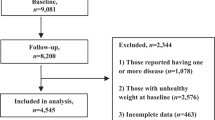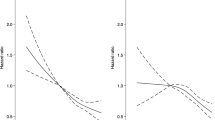Abstract
OBJECTIVE: The aim of this study was to test the hypothesis that specific food intake patterns or changes in food intake patterns were related to future changes in body mass index (BMI).
DESIGN: Longitudinal observational study, with clinical and questionnaire examinations at baseline and two follow-up surveys, after 5 and 11 years.
SUBJECTS: In all, 3785 men and women attended at baseline, of which 2436 aged 30–60 y attended all three examinations.
MEASUREMENTS: A 26-item food frequency questionnaire, standardised measurements of height and weight and a lifestyle questionnaire. Food intake patterns were identified by factor analysis. Regression models including: scores on each factor, BMI, smoking, leisure time physical activity, education, parity, age; and as outcomes: baseline BMI, BMI change between baseline, 5- and 11-y follow-up and obesity at 11-y follow-up, respectively.
RESULTS: For men, three factors labelled ‘Green’, ‘Sweet’ and ‘Traditional’, and for women, two factors labelled ‘Green’ and ‘Sweet-Traditional’ were identified. Scores on the ‘Sweet’ and ‘Sweet-Traditional’ factors were inversely associated with baseline BMI. For men, baseline ‘Traditional’ factor score and, for women, baseline ‘Sweet-Traditional’ factor score was inversely associated with subsequent 11- and 5-y BMI change, respectively. Using the three examinations, a more advanced longitudinal model, which included preceding changes in BMI and factor scores, was tested but no significant associations between factor scores, changes in factor scores and subsequent BMI changes or obesity were found.
CONCLUSION: In this longitudinal study of a Danish population, food intake factors could not consistently predict changes in BMI or obesity development.
This is a preview of subscription content, access via your institution
Access options
Subscribe to this journal
Receive 12 print issues and online access
$259.00 per year
only $21.58 per issue
Buy this article
- Purchase on Springer Link
- Instant access to full article PDF
Prices may be subject to local taxes which are calculated during checkout
Similar content being viewed by others
Notes
The factor analysis of categorical variables in Mplus involves ‘interposed’ continuous variables representing the propensity of a participant to tick a certain category in the FFQ for each food. Thresholds in the hypothetical continuous variables ‘decide’ what categorical answer is given by the participant.
References
World Health Organization. Obesity: preventing and managing the global epidemic. Report of a WHO consultation. World Health organ Tech Rep Ser 2000; 894: (i–xii), 1–253.
Willett WC . Is dietary fat a major determinant of body fat? Am J Clin Nutr 1998; 67: 556S–562S.
Lissner L, Heitmann BL . Dietary fat and obesity: evidence from epidemiology. Eur J Clin Nutr 1995; 49: 79–90.
Jørgensen LM, Sørensen TIA, Schroll M, Larsen S . Influence of dietary factors on weight change assessed by multivariate graphical models. Int J Obes Relat Metab Disord 1995; 19: 909–915.
Togo P, Osler M, Sørensen TIA, Heitmann BL . Food intake patterns and body mass index in observational studies. Int J Obes Relat Metab Disord 2001; 25: 1741–1751.
Jacobson HN, Stanton JL . Pattern analysis in nutrition. Clin Nutr 1986; 5: 249–253.
Kant AK . Indexes of overall diet quality: a review. J Am Diet Assoc 1996; 96: 785–791.
Hu FB, Rimm E, Smith WS, Feskanich D, Stampfer MJ, Ascherio A, Sampson L, Willett WC . Reproducibility and validity of dietary patterns assessed with a food-frequency questionnaire. Am J Clin Nutr 1999; 69: 243–249.
Newby PK, Muller D, Hallfrisch J, Qiao N, Andres R, Tucker KL . Dietary patterns and changes in body mass index and waist circumference in adults. Am J Clin Nutr 2003; 77: 1417–1425.
MONICA data centre. The WHO MONICA project. http://www.ktl.fi/monica/ 2000.
Jørgensen T . Prevalence of gallstones in a Danish population. Am J Epidemiol 1987; 126: 912–921.
Kline P . An Easy Guide to Factor Analysis. Routledge: New York; 1994.
Togo P, Heitmann BL, Sørensen TIA, Osler M . Consistency of food intake factors by different dietary assessment methods and population groups. Br J Nutr 2003; 90: 667–678.
Muthen LK, Muthen BO . Mplus User's Guide, Version 2. Muthen & Muthen: Los Angeles, CA; 2001.
Heitmann BL, Garby L . Patterns of long-term weight changes in overweight developing Danish men and women aged between 30 and 60 years. Int J Obes Relat Metab Disord 1999; 23: 1074–1078.
Wolff CB, Wolff HK . Maternal eating patterns and birth weight of Mexican American infants. Nutr Health 1995; 10: 121–134.
Beaudry M, Galibois I, Chaumette P . Dietary patterns of adults in Quebec and their nutritional adequacy. Can J Public Health 1998; 89: 347–351.
Fung TT, Rimm EB, Spiegelman D, Rifai N, Tofler GH, Willett WC, Hu FB . Association between dietary patterns and plasma biomarkers of obesity and cardiovascular disease risk. Am J Clin Nutr 2001; 73: 61–67.
Gex-Fabry M, Raymond L, Jeanneret O . Multivariate analysis of dietary patterns in 939 Swiss adults: sociodemographic parameters and alcohol consumption profiles. Int J Epidemiol 1988; 17: 548–555.
Barker ME, McClean SI, Thompson KA, Reid NG . Dietary behaviours and sociocultural demographics in Northern Ireland. Br J Nutr 1990; 64: 319–329.
Slattery ML, Boucher KM, Caan BJ, Potter JD, Ma KN . Eating patterns and risk of colon cancer. Am J Epidemiol 1998; 148: 4–16.
Maskarinec G, Novotny R, Tasaki K . Dietary patterns are associated with body mass index in multiethnic women. J Nutr 2000; 130: 3068–3072.
van Dam RM, Grievink L, Ocke MC, Feskens EJ . Patterns of food consumption and risk factors for cardiovascular disease in the general Dutch population. Am J Clin Nutr 2003; 77: 1156–1163.
van Dam RM, Rimm EB, Willett WC, Stampfer MJ, Hu FB . Dietary patterns and risk for type 2 diabetes mellitus in US men. Ann Intern Med 2002; 136: 201–209.
Sanchez-Villegas A, Delgado-Rodriguez M, Martinez-Gonzalez MA, Irala-Estevez J . Gender, age, socio-demographic and lifestyle factors associated with major dietary patterns in the Spanish Project SUN (Seguimiento Universidad de Navarra). Eur J Clin Nutr 2003; 57: 285–292.
Colditz GA, Willett WC, Stampfer MJ, London SJ, Segal MR, Speizer FE . Patterns of weight change and their relation to diet in a cohort of healthy women. Am J Clin Nutr 1990; 51: 1100–1105.
Korkeila M, Rissanen A, Kaprio J, Sørensen TIA, Koskenvuo M . Weight-loss attempts and risk of major weight gain: a prospective study in Finnish adults. Am J Clin Nutr 1999; 70: 965–975.
Schulze MB, Hoffmann K, Kroke A, Boeing H . An approach to construct simplified measures of dietary patterns from exploratory factor analysis. Br J Nutr 2003; 89: 409–419.
Willett WC . Nutritional Epidemiology, 2nd edn. Oxford University Press, Inc.: New York; 1998.
Osler M Heitmann BL . The validity of a short food frequency questionnaire and its ability to measure changes in food intake: a longitudinal study. Int J Epidemiol 1996; 25: 1023–1029.
Fagt S, Trolle E . [Trends in the Danish diet—consumption, purchase and practices. 1. Supply of foods 1955–1990] Udviklingen i danskernes kost—forbrug, indkøb og vaner. Forsyningen af fødevarer 1955–1990. [The Danish Veterinary and Food Administration] Fødevaredirektoratet 2001; 10: 19–66.
McCann SE, Weiner J, Graham S, Freudenheim JL . Is principal components analysis necessary to characterise dietary behaviour in studies of diet and disease? Public Health Nutr 2001; 4: 903–908.
McCann SE, Marshall JR, Brasure JR, Graham S, Freudenheim JL . Analysis of patterns of food intake in nutritional epidemiology: food classification in principal components analysis and the subsequent impact on estimates for endometrial cancer. Public Health Nutr 2001; 4: 989–997.
Ball K, Owen N, Salmon J, Bauman A, Gore CJ . Associations of physical activity with body weight and fat in men and women. Int J Obes Relat Metab Disord 2001; 25: 914–919.
Graff-Iversen S, Skurtveit S, Sørensen M, Nybo A . What are the associations between occupational physical activity and overweight?]. Tidsskr Nor Laegeforen 2001; 121: 2579–2583.
Gutierrez-Fisac JL, Guallar-Castillon P, Diez-Ganan L, Lopez GE, Banegas Jr B, Rodriguez AF . Work-related physical activity is not associated with body mass index and obesity. Obes Res 2002; 10: 270–276.
Hu G, Qiao Q, Silventoinen K, Eriksson JG, Jousilahti P, Lindstrom J, Valle TT, Nissinen A, Tuomilehto J . Occupational, commuting, and leisure-time physical activity in relation to risk for type 2 diabetes in middle-aged Finnish men and women. Diabetologia 2003; 46: 322–329.
Sjøl A, Thomsen KK, Schroll M, Andersen LB . Secular trends in acute myocardial infarction in relation to physical activity in the general Danish population. Scand J Med Sci Sports 2003; 13: 224–230.
Prentice AM, Black AE, Coward WA, Cole TJ . Energy expenditure in overweight and obese adults in affluent societies: an analysis of 319 doubly-labelled water measurements. Eur J Clin Nutr 1996; 50: 93–97.
Heitmann BL, Lissner L . Dietary underreporting by obese individuals—is it specific or non-specific? BMJ 1995; 311: 986–989.
Acknowledgements
We thank Research Unit for Dietary Studies (steering committee: Berit L Heitmann, Lillian Mørch Jørgensen, Merete Osler, Agnes N Pedersen and Marianne Schroll) for making data available. The establishment of Research Unit for Dietary Studies was financed by the FREJA (Female Researchers in Joint Action) programme from the Danish Medical Research Council. The Danish National Science Foundation supported the Danish epidemiology Science Centre. This study was supported by The Danish Medical Research Council the FREJA-programme, a grant from the University of Copenhagen, DK (j.nr. 301-116-5/99) and the Else and Mogens Wedell-Wedellsborgs Foundation (Grant 664).
Author information
Authors and Affiliations
Corresponding author
Rights and permissions
About this article
Cite this article
Togo, P., Osler, M., Sørensen, T. et al. A longitudinal study of food intake patterns and obesity in adult Danish men and women. Int J Obes 28, 583–593 (2004). https://doi.org/10.1038/sj.ijo.0802598
Received:
Revised:
Accepted:
Published:
Issue Date:
DOI: https://doi.org/10.1038/sj.ijo.0802598
Keywords
This article is cited by
-
Trajectories of dietary patterns from pregnancy to 12 years post-pregnancy and associated maternal characteristics: evidence from the Avon Longitudinal Study of Parents and Children
European Journal of Nutrition (2023)
-
Dietary patterns and young adult body mass change: A 9-year longitudinal study
European Journal of Nutrition (2023)
-
Tracking of dietary patterns between pregnancy and 6 years post-pregnancy in a multiethnic Asian cohort: the Growing Up in Singapore Towards healthy Outcomes (GUSTO) study
European Journal of Nutrition (2022)
-
Food consumption and its association with leisure-time physical activity and active commuting in Brazilian workers
European Journal of Clinical Nutrition (2020)
-
Longitudinal 10-year changes in dietary intake and associations with cardio-metabolic risk factors in the Northern Sweden Health and Disease Study
Nutrition Journal (2017)



